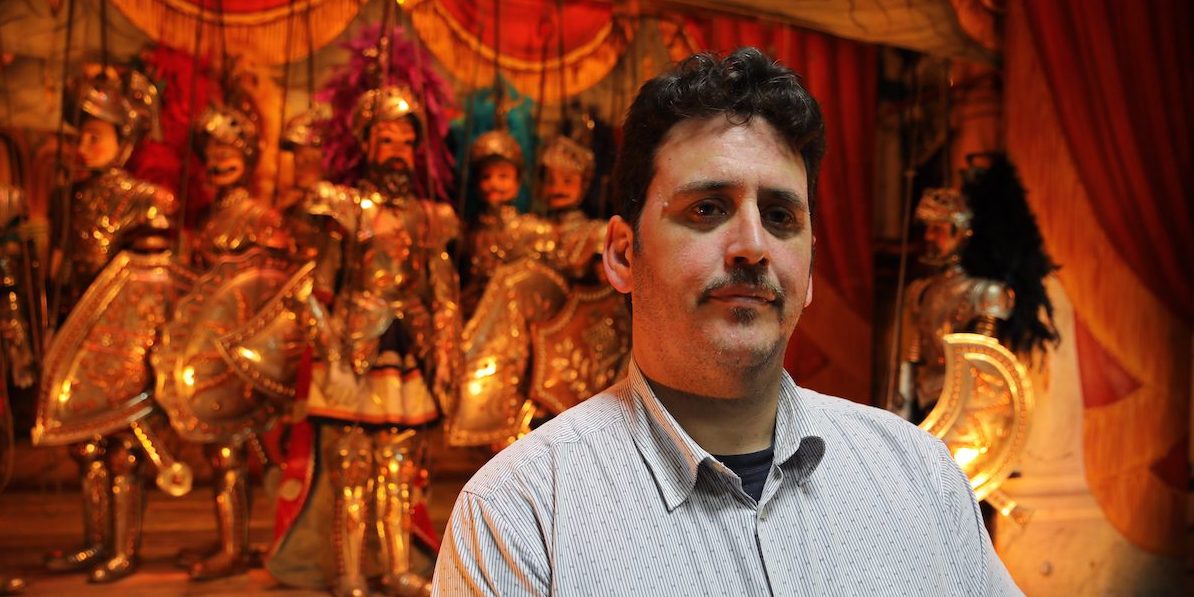When and where does the Opera dei pupi being?
Sicily’s early puppet tradition developed from what was called the vastasate (vastasu in Sicilian today means a vulgar person). In fact, this form of theatre developed this name because the actors used a vulgar form of dialect: they would narrate real-life courtly facts and tailor these artistically to make audiences laugh – usually, male audiences as the content of the performances were felt to not be appropriate for women. The puppets at this time were not yet dressed in armour. During this time, various other forms of storytelling traditions developed, including the canta storie [sung stories] and cunte storie [recounted stories]. These were storytellers who would with sing (cantare) or recount (cuntare in Sicilian) popular stories to the masses. However, once the number of spectators began to decline, the puparo [the puppet master] began to make changes and turned the general finger-puppets into fully-formed puppets, manoeuvred by strings, which all had an iron head and became traditionally dressed in steel armour. At first, the amour was produced from cardboard but during the fight scenes, they would get easily damaged and so the cardboard was replaced with a metal sheet. Today, the puppets are made from three types of metal: alpaca, copper, and brass. This has really marked the starting point for the Opera dei pupi, which, since 2001, is on UNESCO’s List of Intangible Cultural Heritage of Humanity.
How did the repertoires of Opera dei pupi develop?
The repertoires tended to be based on epic-chivalric literature of medieval origin, including Orlando Innamorato [Orlando In Love] (1483) and Orlando Furioso [The Frenzy of Orlando] (1516) by Ludovico Ariosto. Though the stories were not necessarily scripted, each theatre company had its own set of canovacci [sketches] – that is, short scenes or notes about how to carry out various scenes which would then be improvised and, inevitably, different each time. These stories appealed to people as, by that time, Sicily had been in the hands of a number of invading populations so they could relate to the performances. The stories of adventures, love, and betrayal also had a pedagogical value. This was a period with high levels of illiteracy, where few went to school, and this form of popular theatre taught local communities about war, and history and even offered models on how to behave, such as how to respect women and children. As well as this, there were also the occasional serate speciali[special evenings] where the puppeteers would perform religious stories, like those of Santa Rosalia on the Saint’s Patron Day or the death of Christ at Easter.
Was there much spectator participation?
Spectators would definitely participate in the shows. They would cry during scenes, comment on the characters, and even throw shoes at the villain! The intervals used to be longer than they are today (the entire show was about 2 and a half hours whereas today’s shows are about an hour) and so this gave spectators the chance to socialise – some even brought food with them to eat. Back then, people didn’t have televisions like we do today so this became one of the main forms of popular entertainment for the town, and the spectators themselves would follow the Pupari: they would recognise the different voices of the actors and would want to return to see how their stories unfolded on subsequent nights.
How did you develop your craft?
The tradition of the Opera dei pupi is a family-run business that has been passed down for generations, from master to student: from father to son. The puppets are quite heavy (about 10 kilos each) and so the workforce is entirely male. The tradition is also a travelling one: family theatre companies often travelled around the area and nearby cities, similar to the circus traditions today. My grandfather was our founding member in 1928, and his theatre was passed onto my father (who lived until he was 78), and now it has been passed on to me (and maybe one day to my sons). I remember learning the trade at a young age. Children are usually the ones who are in charge of the music: during the performances we would turn the handle of the piano (that is a piano that plays various traditional tunes as you wind it up) and, at the same time, we would learn what the Puparo and co-star were doing as you looked up at the stage – learning the lines of the stories, the different tones of voices, the movements of the puppets, and the various scene changes.
How would you describe the Puparo [puppet master]?
For me, the Puparo is the most “complete” of all actors and theatre practitioners: he is an artisan who makes his own puppets, a director who directs all performances, and an actor who interprets the many characters and voices with his co-star (just one co-star in Palermo). Each Puparo and puppet family had their own style. In Palermo, the puppets are shorter than the ones in Catania. Also, unlike in Catania, our puppets can kneel and they keep their swords in their pockets. This way, we try to make the puppets seem more human-like.
How do you see the future of the Opera dei pupi?
The future is a big question mark. We are definitely trying to reach out to new international audiences. We now provide theatre programmes in various languages to help foreign audiences follow the drama, though the productions are extremely physical so no one is ever lost in translation! Our motto is Rinnovare senza abbandonare [renewing without abandoning]; that is, we try to renew our craft without ever losing its local flavour. We want to stay faithful to our art form and, in turn, share our traditions, folklore, and culture with people from all around the world.
Book now for shows, talks, workshops in Palermo, see www.mancusopupi.it and https://www.facebook.com/teatrocarlomagno

